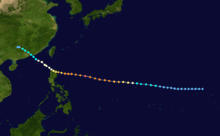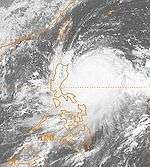Typhoon Peggy (1986)
| Typhoon (JMA scale) | |
|---|---|
| Category 5 (Saffir–Simpson scale) | |
 Typhoon Peggy near peak intensity on July 6 east of the Philippines | |
| Formed | July 3, 1986 |
| Dissipated | July 11, 1986 |
| Highest winds |
10-minute sustained: 205 km/h (125 mph) 1-minute sustained: 260 km/h (160 mph) |
| Lowest pressure | 900 hPa (mbar); 26.58 inHg |
| Fatalities | 422+ |
| Damage | $2.5 million (1986 USD) |
| Areas affected | Philippines, China |
| Part of the 1986 Pacific typhoon season | |
Typhoon Peggy, known in the Philippines as Typhoon Gading, was a very intense super typhoon that formed during the 1986 Pacific typhoon season. At the time of its occurrence, the typhoon was documented by PAGASA as the eight strongest Philippine typhoon on record.[1]
Typhoon Peggy made landfall in the Philippines on July 9 and made landfall in China on July 11. Peggy caused at least 333 deaths and $2.50 million (1986 USD) in damage.[2]
Meteorological history

A tropical depression developed on July 3 east of the Philippines, and strengthened to a tropical storm the next day. It steadily strengthened to a typhoon, then continued to intensify and reached a peak strength of 130 knots (240 km/h; 150 mph) – Category 5 on the SSHS – on July 7. As Peggy continued westward, it slowly weakened, and hit northeastern Luzon on July 9 as a 90 knots (170 km/h; 100 mph) 90 kn Category 2 typhoon. A slight weakening of the subtropical ridge brought Peggy northward, where it hit southeastern China as a 55 knots (102 km/h; 63 mph) tropical storm on July 11. In Hong Kong, winds gusted to 78 knots (144 km/h; 90 mph) at Tate's Cairn and rainfall totals reached 449 millimetres (17.7 in) at Tai Mo Shan.[3] Peggy's fury resulted in 333 casualties and US$2.5 million (1986 dollars) in damage, mostly from torrential flooding.[4] It weakened and later dissipated into a remnant low on July 12.
Impact

Typhoon Peggy hit the northern Philippines on July 9 with 1-minute sustained surface winds of 95 knots (110 mph; 175 km/h). The storm caused high winds that destroyed homes and triggered floods. Peggy killed 93 people in northern Luzon, injured 16, and affected at least 644,600 people; it damaged about 6,680 houses and caused at least $30,710,000 in economic cost.[4] The total number of casualties from Peggy was even greater; PAGASA reported 109 casualties in the Philippines.[3]
Peggy made its second and final landfall in China as a weak tropical storm – however, this was in Hong Kong. Peggy dropped torrential rainfall that triggered deadly floods.[5]
See also
References
- ↑ "Strongest Typhoons of the Philippines (1947 - 2009)". Typhoon2000.com. MeteoGroup. July 29, 2010. Retrieved May 31, 2014.
- ↑ Peggy in China, retrieved by the JTWC.
- 1 2 "Most Destructive Tropical Cyclones for the Month of July (1948-2000)". Philippine Atmospheric, Geophysical and Astronomical Services Administration. Archived from the original on 2006-09-25. Retrieved 2011-06-07.
- 1 2 1986 Annual Tropical Cyclone Report (PDF). Joint Typhoon Warning Center (Report). Guam, Mariana Islands: United States Navy. 1986. Retrieved May 28, 2014.
- ↑ "China - Typhoons/Floods Jul 1986 UNDRO Information Reports 1-6" (Situation Report). United Nations Department of Humanitarian Affairs. July 15, 1986. Retrieved June 2, 2014.